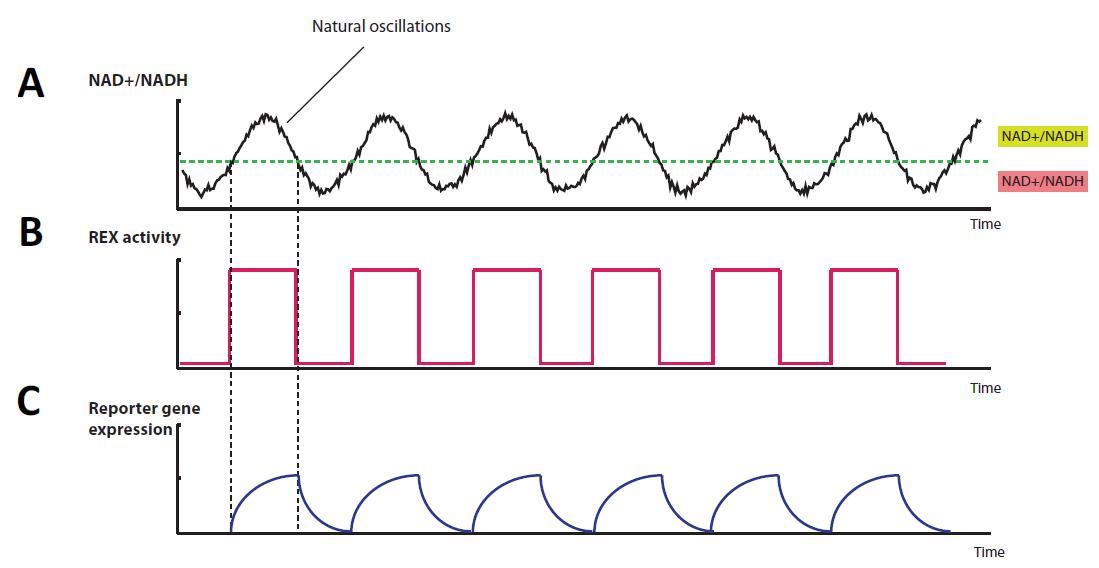Team:DTU Denmark/applications private securkey Dhjg1mab2ak47
From 2009.igem.org
| Line 225: | Line 225: | ||
<br> | <br> | ||
</html> | </html> | ||
| - | [[Image:oscillations.jpg| | + | [[Image:oscillations.jpg|600px|thumb|center|The redox coupled system]] |
<html> | <html> | ||
Revision as of 21:10, 18 October 2009

| Home | The Team | The Project | Parts submitted | Modelling | Notebook |
|
The redoxilator - Introduction - Results - Applications and perspectives The USERTM assembly standard - Principle - Proof of concept - Manual USERTM fusion primer design software - Abstract - Instructions - Output format |
The Redoxilator Applications and perspectives There are numerous potential applications for our genetic device, but here we have highlighted three key applications: an in vivo redox sensor, improved chemostat product formation and applications in cancer research. i) Reporter gene expression regulated by the Rexivator – an in vivo redox sensorThe gene encoding green fluorescent protein (GFP) is widely used as a reporter gene in molecular biology. By placing the ROB promoter upstream of a GFP gene on a plasmid, and transforming the whole system into a yeast cell, GFP will be expressed at certain NAD+/NADH levels. When the Rexivator is bound to DNA, GFP expression will produce a visible and quantitatively measurable signal, which will be an indirect measure of the NAD+/NADH ratio.
In vivo online redox sensor. The measuring of cellular NAD+/NADH levels is usually a difficult process, especially due to fast changes in NAD+/NADH ratio that can occur when a sample is taken and exposed to slightly new conditions. With this sensor system, the quantitative measurement of the reporter gene will provide a fast and reliable way to determine the NAD+/NADH ratio in vivo. The plasmid can be transformed into a yeast strain allowing the NAD+/NADH ratio to be continuously monitored. As an example this plasmid can be used to study whether an engineered yeast strain has an altered NAD+/NADH ratio. The plasmid can be transformed into different yeast strains (e.g. wild type versus an engineered strain or two production strains) and the NAD+/NADH ratio can be compared. ii) Product formation regulated by the Rexivator – an attempt to improve and prolong chemostat processes When S. cerevisiae are grown continuously in a chemostat, the productivity of e.g. antibiotic or protein product gradually decreases [Personal correspondence with Novo Nordisk A/S]. This occurs during maximum production and is believed to be the result of metabolic adaption8 with reduced product formation as a consequence. The metabolic adaption is believed to occur because the cells are stressed by the extensive production. The cells will adapt to the new metabolic situation, which will gradually lead to lower production rates. This is highly undesirable in the biotech industry, as the chemostats will have to be restarted on a regular basis, which is costly and time consuming.
Qualitative simulation of a chemostat fermentation with the Rexivator Production system A strategy to lower the effect of the metabolic adaption could be to couple the productivity with the yeast metabolic cycle (see grey box to the right). The NAD+/NADH poise oscillates in parallel with the yeast metabolic cycle. The synthesis of a given product will be put under control of the Rexivator, which will lead to periodic burst of gene expression leading to product formation. Consequently the cells will have time to recover periodically from the metabolic stress that occurs during the production phase. There are many indications that this will lead to a prolonged effective chemostat operation, and ultimately higher accumulation of product before a costly restart of the chemostat is required.
We have conducted several fermentations and found a strong indication that it is favourable to let the cells produce in the oxidative phase for the tested product (the specific product cannot be mentioned due to ip-rights).
Yeast is used as a model organism for humans in many research projects. As an example, studies of the yeast cell cycle have paved the way for most of the knowledge about the cell cycle in mammalian cells. As yeast has been widely used as a model organism for studying cancer an integrated tool for detecting a significant change in the redox potential would ease this research, especially because a rising NADH level is seen as a hallmark of carcinogenesis. |
The yeast metabolic cycle It has recently been shown by Tu et al. and Klevecz et al. that the expression of at least half of the genes monitored on a standard yeast gene chip will oscillate in a coordinated manner when grown under glucose limited conditions. The cells will shift between oxidative and reductive metabolism in a synchronized metabolic cycle with three phases: oxidative, reductive/building and reductive/ charging. As oxygen will only be consumed in the oxidative phase, the dissolved oxygen will oscillate. Many metabolites and cofactors including NADH and NAD+ will also oscillate during this cycle as NADH is converted to NAD+ when oxygen is consumed. |
| Comments or questions to the team? Please Email us -- Comments of questions to webmaster? Please Email us |
 "
"


